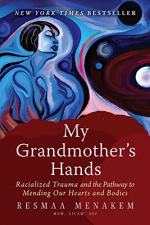|
This section contains 739 words (approx. 2 pages at 400 words per page) |

|
My Grandmother's Hands Summary & Study Guide Description
My Grandmother's Hands Summary & Study Guide includes comprehensive information and analysis to help you understand the book. This study guide contains the following sections:
This detailed literature summary also contains Topics for Discussion on My Grandmother's Hands by Resmaa Menakem.
The following version of this book was used to create the guide: Menakem, Resmaa. My Grandmother's Hands: Racialized Trauma and the Pathway to Mending Our Hearts and Bodies. Central Recovery Press, 2017.
The purpose of My Grandmother's Hands: Racialized Trauma and the Pathway to Mending Our Hearts and Bodies is to heal the traumatized body. Trauma occurs in the aftermath of a highly stressful situation and may be experienced as a "wordless story." Trauma may also be passed from generation to generation. In this way, trauma is essentially in our blood.
Also present in our bodies is the trauma of white-body supremacy. Even if people believe they have transcended this elevation of the white body, they have not. It is encoded in all bodies. The most pressing need right now is to mend the pain of this white-body supremacy. This pain may manifest in two ways: the clean pain of acting from the best parts of oneself or the dirty pain of blame and denial. One of the most helpful things people can do is to metabolize their pain and heal their own trauma. My Grandmother's Hands shows how to settle the body after great pain.
What is the origin of this white-body trauma and pain? Menakem theorizes that this trauma originated in white bodies thousands of years ago because human history is a history of butchering, torturing, enslaving, and colonizing. The white bodies that took part in this trauma passed it down to their children and to their children's children. In this way, trauma came to exist to the present day.
More specifically, in the seventeenth century, the concept of "whiteness" itself was invented. In the 1680s, the first recorded phrases of "white person," "white woman," and "white man" appeared. Race was carefully constructed as a means by which to elevate those with white skin and give them small parcels of land as well as dominion over Black bodies. In contrast to the burgeoning white-body supremacy, Black bodies were seen as dangerous, unattractive, and impervious to pain. Furthermore, these bodies were seen as superhumanly strong, hypersexual, and dirty. They needed to be controlled. Unfortunately, many Black men and women have internalized these judgments and continue to suffer from traumatic retentions (such as colorism and self-repulsion).
Black people also continue to suffer because of the widespread myth of white fragility. Of course, whiteness does not equal fragility, and white people should not look to Black people to make them more comfortable and less afraid. White people must learn how to soothe themselves from the "lizard-brain" defensiveness they experience. Additionally, white people must learn how to take responsibility for metabolizing their own historical pain.
Furthermore, white and Black police bodies must learn to mend their own pain. They are under constant stress and must learn how to develop a growth routine and practice self-care (including good nutrition and enough sleep). They must also learn how to practice the five anchors when they notice conflict building. These anchors are 1) Soothe yourself to quiet your mind, calm your heart, and settle your body, 2) Simply notice the sensations, vibrations, and emotions in your body instead of reacting to them. 3) Accept the discomfort--and notice when it changes--instead of trying to flee from it, 4) Stay present and in your body as you move through the unfolding experience, with all its ambiguity and uncertainty, and respond from the best parts of yourself, and 5) Safely discharge any energy that remains (168-171).
Practicing these five anchors whenever possible will make healthy police bodies that in turn make better decisions in their community policing. Police officers should always remember that it is crucial to put their bodies in the neighborhoods they police (instead of staying in a patrol car), and they should offer help and community resources whenever possible. Small overtures like contacting the city about a broken streetlight and rescuing a cat from a tree will, in time, build trust in the community. Ideally, police bodies and community bodies should join together to host health and safety programs.
Finally, white, Black, and police bodies will be able to embrace body-centered social activism. Activists must continue to learn how to take care of their own bodies and other bodies as well. Mastering physical and psychological first aid (recognizing and responding to trauma) is essential. Social activism at its best will change the world in positive ways and create a new culture that calls out and rejects white-body supremacy.
Read more from the Study Guide
|
This section contains 739 words (approx. 2 pages at 400 words per page) |

|



